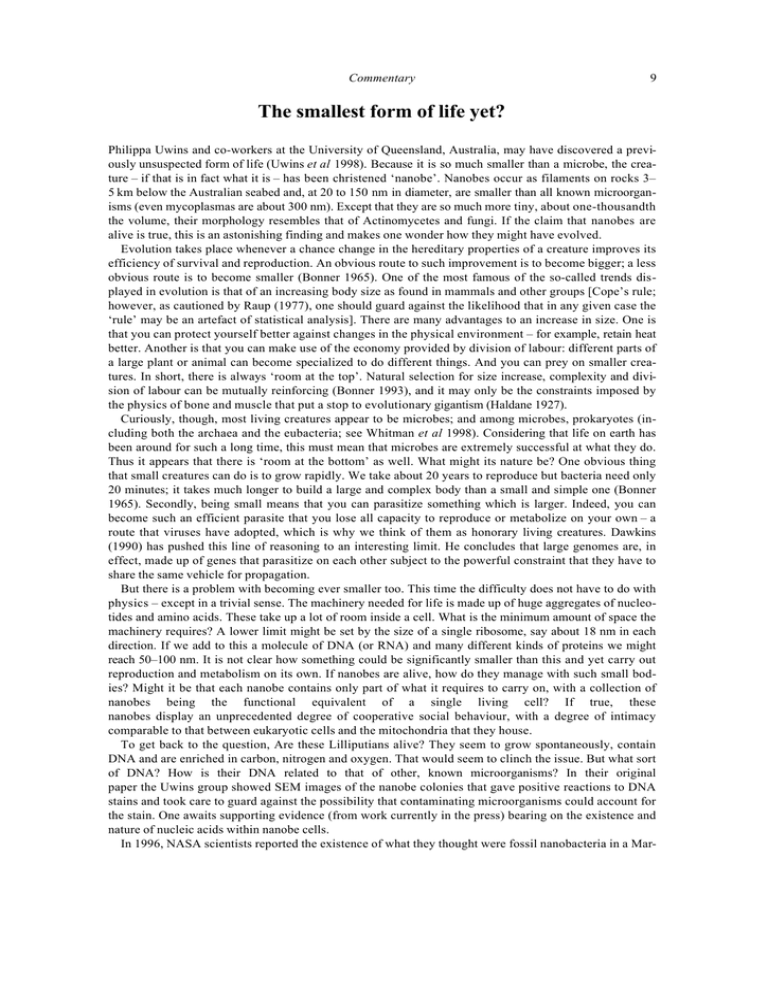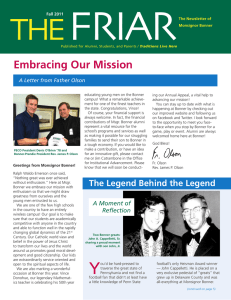The smallest form of life yet?
advertisement

Commentary 9 The smallest form of life yet? Philippa Uwins and co-workers at the University of Queensland, Australia, may have discovered a previously unsuspected form of life (Uwins et al 1998). Because it is so much smaller than a microbe, the creature – if that is in fact what it is – has been christened ‘nanobe’. Nanobes occur as filaments on rocks 3– 5 km below the Australian seabed and, at 20 to 150 nm in diameter, are smaller than all known microorganisms (even mycoplasmas are about 300 nm). Except that they are so much more tiny, about one-thousandth the volume, their morphology resembles that of Actinomycetes and fungi. If the claim that nanobes are alive is true, this is an astonishing finding and makes one wonder how they might have evolved. Evolution takes place whenever a chance change in the hereditary properties of a creature improves its efficiency of survival and reproduction. An obvious route to such improvement is to become bigger; a less obvious route is to become smaller (Bonner 1965). One of the most famous of the so-called trends displayed in evolution is that of an increasing body size as found in mammals and other groups [Cope’s rule; however, as cautioned by Raup (1977), one should guard against the likelihood that in any given case the ‘rule’ may be an artefact of statistical analysis]. There are many advantages to an increase in size. One is that you can protect yourself better against changes in the physical environment – for example, retain heat better. Another is that you can make use of the economy provided by division of labour: different parts of a large plant or animal can become specialized to do different things. And you can prey on smaller creatures. In short, there is always ‘room at the top’. Natural selection for size increase, complexity and division of labour can be mutually reinforcing (Bonner 1993), and it may only be the constraints imposed by the physics of bone and muscle that put a stop to evolutionary gigantism (Haldane 1927). Curiously, though, most living creatures appear to be microbes; and among microbes, prokaryotes (including both the archaea and the eubacteria; see Whitman et al 1998). Considering that life on earth has been around for such a long time, this must mean that microbes are extremely successful at what they do. Thus it appears that there is ‘room at the bottom’ as well. What might its nature be? One obvious thing that small creatures can do is to grow rapidly. We take about 20 years to reproduce but bacteria need only 20 minutes; it takes much longer to build a large and complex body than a small and simple one (Bonner 1965). Secondly, being small means that you can parasitize something which is larger. Indeed, you can become such an efficient parasite that you lose all capacity to reproduce or metabolize on your own – a route that viruses have adopted, which is why we think of them as honorary living creatures. Dawkins (1990) has pushed this line of reasoning to an interesting limit. He concludes that large genomes are, in effect, made up of genes that parasitize on each other subject to the powerful constraint that they have to share the same vehicle for propagation. But there is a problem with becoming ever smaller too. This time the difficulty does not have to do with physics – except in a trivial sense. The machinery needed for life is made up of huge aggregates of nucleotides and amino acids. These take up a lot of room inside a cell. What is the minimum amount of space the machinery requires? A lower limit might be set by the size of a single ribosome, say about 18 nm in each direction. If we add to this a molecule of DNA (or RNA) and many different kinds of proteins we might reach 50–100 nm. It is not clear how something could be significantly smaller than this and yet carry out reproduction and metabolism on its own. If nanobes are alive, how do they manage with such small bodies? Might it be that each nanobe contains only part of what it requires to carry on, with a collection of nanobes being the functional equivalent of a single living cell? If true, these nanobes display an unprecedented degree of cooperative social behaviour, with a degree of intimacy comparable to that between eukaryotic cells and the mitochondria that they house. To get back to the question, Are these Lilliputians alive? They seem to grow spontaneously, contain DNA and are enriched in carbon, nitrogen and oxygen. That would seem to clinch the issue. But what sort of DNA? How is their DNA related to that of other, known microorganisms? In their original paper the Uwins group showed SEM images of the nanobe colonies that gave positive reactions to DNA stains and took care to guard against the possibility that contaminating microorganisms could account for the stain. One awaits supporting evidence (from work currently in the press) bearing on the existence and nature of nucleic acids within nanobe cells. In 1996, NASA scientists reported the existence of what they thought were fossil nanobacteria in a Mar- 10 Commentary tian meteorite. (The material that formed the meteorite solidified on Mars 4·5 billion years ago, was shot into space by another meteorite that hit Mars, voyaged in space for 16 million years, fell in Antarctica about 13,000 years ago and was discovered in 1984.) That claim attracted a great deal of controversy and scepticism. Till today there have been no reports of anything like the Martian forms seen in fossils on Earth, which has (unfairly) added to the scepticism. Uwins’s nanobes are roughly the same size as those nanobacteria but otherwise quite different. To sum up, we still lack conclusive evidence for the occurrence of reproduction and metabolism in nanobes. Nor, assuming that they are living creatures, do we have a plausible hypothesis regarding their evolutionary antecedents. But, until we do, the possibilities for speculation remain fascinating. References Bonner J T 1965 Size and cycle (Princeton: Princeton University Press) Bonner J T 1993 Life cycles (Princeton: Princeton University Press) Dawkins R 1990 Parasites, Desiderata Lists and the Paradox of the Organism; Parasitology 100 S63–S73 Haldane J B S 1927 On being the right size; in Possible Worlds and Other Essays (London: Chatto and Windus) Raup D M 1977 Stochastic models in evolutionary palaeontology; in Patterns of evolution, as illustrated by the fossil record (ed.) A Hallam (Amsterdam: Elsevier) pp 59–78 Uwins P J R, Webb R I and Taylor A P 1998 Novel nano-organisms from Australian sandstones; Am. Mineral. 83 1541–1550 Whitman W B, Coleman D C and Wiebe W J 1998 Prokaryotes: The Unseen Majority; Proc. Natl. Acad. Sci. USA 95 6578–6583 VIDYANAND NANJUNDIAH Indian Institute of Science and Jawaharlal Nehru Centre for Advanced Scientific Research, Bangalore 560 012, India (Email: vidya@ces.iisc.ernet.in) J. Biosci. | vol. 25 | No. 1 | March 2000



